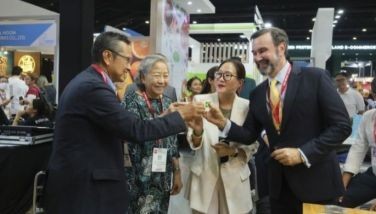Rizal sesquicentennial: Rizal the Patriot & Martyr (Final)
CEBU, Philippines - He was arrested on July 6, 1892. Governor General Eulogio Despujol published in the Gazette the reasons for his arrest and copies were forwarded to the Spanish Embassy in Hong Kong for circulation.
The British Consul issued an unofficial statement on the strange manner he was arrested. The editor of the Hong Kong Telegraph devoted an entire column of the newspaper on the sad news of his detention. Therewith, he was deported to Dapitan on July 15, 1892. Because he did not retract masonry even at the advice of his Jesuit teachers in Ateneo, he had to stay with Ricardo Carnicero, the Military commandant in Dapitan.
In Dapitan, seeing the need of the people there, he established a clinic, school, and improved the lighting and water system. On Sundays, together with Father Sanchez, one of his favorite teachers in Ateneo, he conducted religious classes for the inhabitants. He bought a piece of land in Sitio Talisay where he planted coconuts, sugarcane, cacao, and various fruit trees. Loneliness impelled him to write Mi Retiro. But he reflected the strength of his spirit when he wrote Hymn to the Talisay Tree.
He corresponded unceasingly with Blumentritt. He gathered specimens of Philippine animal life and sent them to the museum at Dresden, Germany. Besides his close relatives who visited him in Dapitan, an Irish girl came to Dapitan with her blind foster father, Engineer George Tauffer, who needed eye treatment. She was Josephine Bracken who later became his wife.He explored the coast of Mindanao. Sometimes he stayed for several days. Some of his friends offered to spirit him away or pick him up far out at sea to bring him to Singapore, but he refused.
He applied for the position of surgeon in Cuba where the Spanish soldiers were badly afflicted with diseases while fighting the rebels under Jose Marti. Granted his request, he sailed for Manila on July 31, 1896 only to find out that the boat that was to take him to Cuba had already left the day before. As he was still under detention, he was transferred to the Castilla then anchored in Cavite. The thought of resuming his travels inspired him to write the poem The Song of the Traveler.
He was finally able to sail for Spain aboard the Isla de Panay which took him to Singapore. While this was refueling at Singapore, Pedro Roxas urged him to leave the boat assuring him that he would be safe and free from his enemies under the British Territory. He refused.
On September 30, 1896 while the boat was in the Middle East, the ship captain received a telegram order for his arrest. The Philippine Revolution had finally erupted. Brought to Barcelona, he was lodged in Montjuich Penitentiary and was ordered the next day to take his baggage on board the Colon that would take him to Manila to stand trial.
At Singapore, while the boat was at dock, a writ of habeas corpus was filed in the Supreme Court of the Straits Settlements for his release on the ground that he was illegally detained. The move was inspired by Dr. Antonio Ma. Regidor of London and some British lawyers who, through Lord Hugh Fort, attempted to free him by court proceedings. But Judge Lionel Cox ruled that the Colon was a troopship flying the Spanish Flag and that he was a Spanish subject. Therefore his case was not under British jurisdiction.
Upon his arrival in Manila on November 3, 1896, he was imprisoned in Fort Santiago. On November 26, he was tried by the military court presided by Judge Advocate Enrique Alcocer at the Cuartel de España. In spite of the spirited defense of his counsel, Lieutenant Luis Taviel de Andrade, on the charges of rebellion, sedition and illegal organization of societies against him, he was meted the death penalty. He was not able to confront the witnesses who testified against him. Incriminating information linking him to the rebellion was just read to him.
On the eve prior to his execution he wrote the poem Mi Ultimo Adios which he hid in the alcohol burner. Presumably he retracted masonry; married Josephine Bracken before a priest, with guards as witnesses, and wrote letters to professor Blumentritt, to his brother Paciano; and to his beloved father and mother.
On December 30, 1896, he was marched out of Fort Santiago toward Bagumbayan Field. With him were Fathers March and Villaclara and his legal counsel, Luis Taviel de Andrade. Before he left Fort Santiago he gave the alcohol burner in which he hid the poem, Mi Ultimo Adios, to his sister, Trinidad, and to his wife Josephine, he gave the book of Thomas Kempis, Imitation of Christ. He handed his belt to his nephew, Mauricio, before he was shot to death.
The Spanish doctor, Ruiz y Castillo felt his pulse and found it normal. He faced the all-Filipino soldiers of the firing squad who were in turn heavily guarded by the Spanish soldiers, toward Manila Bay. Volleys were fired. He fell but with a great effort, he turned about face and fell facing his executioners.
Because the authorities feared the people might riot, they had him buried in Paco Cemetery with his name’s initials reversed – R.P.J. On August 17, 1898, his sisters had his grave dug and found out that he was buried without a coffin. Only his hat and shoes remained.
Source: Filipinos in History (Volume 1), a publication of the National Historical Commission of the Philippines. (FREEMAN)
- Latest
- Trending























